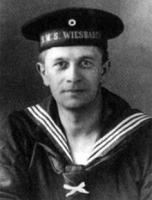Singer/songwriter Tom Munch plays his original song about the last great historic wooden schooners of Maine in the early 20th century. The photos are historic shots of the Wyoming and other ships built at Percy and Small shipyard in Bath, Maine and elsewhere.
 June 25th is celebrated globally as the Day of the Seafarer, an official United Nations observance day. What does that really mean? Opinions vary. Click here to read Barista Uno’s slightly acerbic but largely on-target perspective on the official “observance day.” Nevertheless, it is always worthwhile to remember the roughly 1.2 million seafarers who operate the 50,000 merchant ships traveling the globe, which carry 90% of all world trade.
June 25th is celebrated globally as the Day of the Seafarer, an official United Nations observance day. What does that really mean? Opinions vary. Click here to read Barista Uno’s slightly acerbic but largely on-target perspective on the official “observance day.” Nevertheless, it is always worthwhile to remember the roughly 1.2 million seafarers who operate the 50,000 merchant ships traveling the globe, which carry 90% of all world trade.
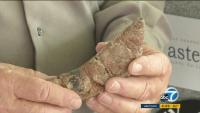 You never know what you will find in a landfill. Paleontologist Melissa Macias was looking for fossils in the Bowerman Landfill in Irvine, California, when she spotted teeth and bones as a construction crew moved soil to create a new waste disposal area. They turned out to be 18 teeth, a flipper bone and portions of the jaw and skull of a sperm whale, all well preserved. The fossils are believed to be 10-12 million years old.
You never know what you will find in a landfill. Paleontologist Melissa Macias was looking for fossils in the Bowerman Landfill in Irvine, California, when she spotted teeth and bones as a construction crew moved soil to create a new waste disposal area. They turned out to be 18 teeth, a flipper bone and portions of the jaw and skull of a sperm whale, all well preserved. The fossils are believed to be 10-12 million years old.
Macias says that she was lucky to have spotted the fossils. “Three feet one direction it would have been taken out before I found it. Three feet to the other direction, it would have stayed buried,” she said.
Johann Wilhelm Kinau was one of the more than 8,000 sailors who died in the Battle of Jutland just over 100 years ago. Kinau was 36 when he was killed while serving as a lookout on the German light cruiser SMS Wiesbaden. Kinau is better remembered by his pen name, Gorch Foch, the sailor poet and writer. The son of a fisherman, he worked as an accountant at a Hamburg-Amerika-Linie in Hamburg. In 1904 at the age of 24, he started publishing poetry in Low German. His most popular work, the novel Seefahrt ist Not! (Seafaring is Necessary) was published in 1913.The novel describes the lives of the deep sea fishermen of his home island of Elbe of Finkenwerder. Kinau was drafted into the German Navy two years later.
Although he died quite young, his legacy has endured. The first of three sailing school ships built for the German Reichsmarine starting in 1933 was named Gorch Foch in his honor. Continue reading
 Congratulations to the schooner Spirit of South Carolina and all who sail and support her! After languishing for years, the schooner has new owners, a new captain and officers and was recently re-certified to carry passengers by the US Coast Guard. She will soon be sailing North to New England for a program of port visits and teen summer camps before returning to South Carolina in October.
Congratulations to the schooner Spirit of South Carolina and all who sail and support her! After languishing for years, the schooner has new owners, a new captain and officers and was recently re-certified to carry passengers by the US Coast Guard. She will soon be sailing North to New England for a program of port visits and teen summer camps before returning to South Carolina in October.
A few years ago, we posted about “The Unfortunate Economics of Tall Ships.” Finding the money to operate a tall or historic ship is a tough business. More fail than succeed. One of the several ships we mentioned that had fallen on hard times was the schooner Spirit of South Carolina. The 140′ schooner’s keel was laid in 2001 and she was launched in 2007. She was put up for sale in 2011 when the foundation that built and operated her ran into financial problems. For several years, there were no buyers. Finally, in 2014, the bank which held her mortgage sold her at auction to two Charleston businessmen, Tommy Baker and Michael Bennett. They have brought the schooner back into service and will be operating her as a 501 (c)(3) non-profit organization. Receiving the USCG Certificate of Inspection (COI) is a major milestone.
 After being tied to the dock for several years, the ARA Libertad, the Argentine Navy’s training ship, is sailing again. For the last three years, the ship has been entangled in a more than decade long battle over Argentine debt related to a financial crisis in 2002. In early March, Argentina settled the dispute with its remaining creditors, including several US hedge fund “vulture” capitalists, and shortly thereafter, ARA Libertad was made ready for sea. On June 3-7, she sailed to the US to participate in Sail Baltimore. She then sailed for Norfolk where she was one of the featured attractions at Norfolk Harborfest from June 9-12. Last week ARA Libertad was at Pier 86 in New York before sailing for Amsterdam on Saturday.
After being tied to the dock for several years, the ARA Libertad, the Argentine Navy’s training ship, is sailing again. For the last three years, the ship has been entangled in a more than decade long battle over Argentine debt related to a financial crisis in 2002. In early March, Argentina settled the dispute with its remaining creditors, including several US hedge fund “vulture” capitalists, and shortly thereafter, ARA Libertad was made ready for sea. On June 3-7, she sailed to the US to participate in Sail Baltimore. She then sailed for Norfolk where she was one of the featured attractions at Norfolk Harborfest from June 9-12. Last week ARA Libertad was at Pier 86 in New York before sailing for Amsterdam on Saturday.

Photo: Classis Harbor LInes
Classic Harbor Line‘s schooner America 2.0 is a fascinating design. Designed and built by the Scarano brothers and delivered in 2011, the boat is, notionally, a replica of the schooner yacht America of 1851, after which the famous America’s Cup was named. America 2.0 might be called a modern interpretation of the original. It could also be called a hybrid or even simply a modern high-tech schooner. The Classic Harbor line website refers to it as a “tribute to the first schooner America.” Whatever you call the schooner, it is worth taking a closer look.
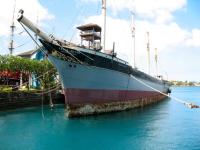 In May 2015, we posted that the State of Hawaii has put the Friends of Falls of Clyde, the organization responsible for rescuing the historic ship of the same name, on notice that the state planned to terminate the permit which allowed the ship to be docked for free in Honolulu. “They received the ship from the Bishop Museum with the understanding it would go into dry dock quickly. It has been 6 years and it doesn’t appear we are any closer to putting it into dry dock,” said Hawaii State Department of Transportation Deputy Director Darrell Young. Now, a year later, the state apparently has had enough. They have revoked a permit that allowed the Falls of Clyde to moor at Pier 7 and given the Friends of Falls of Clyde until July 15th to move the vessel and restore Pier 7 to a safe condition.
In May 2015, we posted that the State of Hawaii has put the Friends of Falls of Clyde, the organization responsible for rescuing the historic ship of the same name, on notice that the state planned to terminate the permit which allowed the ship to be docked for free in Honolulu. “They received the ship from the Bishop Museum with the understanding it would go into dry dock quickly. It has been 6 years and it doesn’t appear we are any closer to putting it into dry dock,” said Hawaii State Department of Transportation Deputy Director Darrell Young. Now, a year later, the state apparently has had enough. They have revoked a permit that allowed the Falls of Clyde to moor at Pier 7 and given the Friends of Falls of Clyde until July 15th to move the vessel and restore Pier 7 to a safe condition.
A statement from the Hawaii Department of Transportation Harbors Division (HDOT Harbors) reads, in part: The condition of the Falls of Clyde poses an unacceptable risk to navigation in Honolulu Harbor and a safety and security risk to harbor users.
The Friends of Falls of Clyde were asked to provide proof that they had the resources necessary to restore the vessel to a condition that would allow it to safely berth in Honolulu Harbor. They were unable to meet this request.
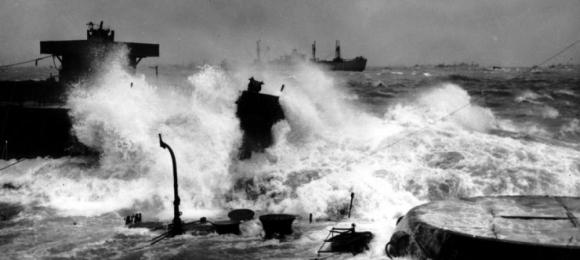
Mulberry harbor in the storm of June 19-22, 1944
Seventy-two years ago today, during the early days of the Allied invasion of Europe, the sea would prove to be as formidable an enemy as the Germans. A storm, the worst in 80 years, came close to wiping out the Mulberrys, the two portable harbors built at Normandy to support the invasion.
One of the challenges of invading Europe over the Normandy beaches in World War II was that there were no convenient harbors to unload men and supplies. British engineers came up with the idea of fabricating modular docks to create temporary harbors. They were called Mulberry harbors, a name chosen at random.
 Guirec Soudée, a 24 year old sailor, has spent the last two years sailing the globe with a female chicken named Monique. Soudée began the cruise in the Canary Islands in May 2014, sailing to St. Barts in the Caribbean and then to Greenland on his boat, Yvinec. Apparently, Monique has proven to be both good company and a reliable producer of eggs.
Guirec Soudée, a 24 year old sailor, has spent the last two years sailing the globe with a female chicken named Monique. Soudée began the cruise in the Canary Islands in May 2014, sailing to St. Barts in the Caribbean and then to Greenland on his boat, Yvinec. Apparently, Monique has proven to be both good company and a reliable producer of eggs.
“I knew she was the one straight away,” Guirec told the BBC from western Greenland, where he is now moored.
“She was only about four or five months old then, and had never left the Canary Islands. I didn’t speak any Spanish and she didn’t speak any French, but we got along.”
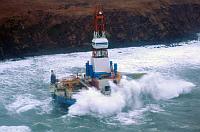
Shell rig Kulluck aground 2013
Last week, Repsol, the last of a group oil companies which had invested billions of dollars in Arctic drilling rights in Alaska’s Chukchi Sea, abandoned its leases and sailed away. The Spanish drilling company gave up 55 leases and plans to drop the remaining 38 next year. Repsol had been preceded in abandoning Arctic drilling by Shell, ConocoPhillips, Eni, and Iona Energy.
Shell had invested a reported $7 billion in their failed attempt to drill in the environmentally sensitive region. Shell’s efforts resulted in environmental protests, multiple ship and drill rig groundings, repeated technical failures, and citations for safety and pollution violations. The finally succeeded in drilling one exploration well, which turned out to be a dry hole.
While Shell proved to be largely incapable of coping with the Arctic conditions, what ultimately doomed Arctic drilling was the price of oil. Shell began in the Arctic when oil was above $100 per barrel. When they left it was bouncing around $50 a barrel.
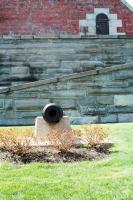 Defending New York Harbor: The City’s Waterfront Forts is an exhibit of photographs by Richard W. Golden which documents the fortifications that protectively ring New York Harbor. It is on view at the historic Cutter Lilac through July 31st during regular hours. An opening reception will be held on Thursday, June 16 from 5:00 to 7:00 PM. This event is free and open to the public. Cash bar. Those under 21 must be accompanied by an adult guardian. Lilac is open to the public, free of charge from 4:00 to 7:00 PM on Thursdays and 2:00 to 7:00 PM on Saturdays and Sundays. Lilac is berthed at Hudson River Park’s Pier 25 in Manhattan at West Street and N. Moore Street.
Defending New York Harbor: The City’s Waterfront Forts is an exhibit of photographs by Richard W. Golden which documents the fortifications that protectively ring New York Harbor. It is on view at the historic Cutter Lilac through July 31st during regular hours. An opening reception will be held on Thursday, June 16 from 5:00 to 7:00 PM. This event is free and open to the public. Cash bar. Those under 21 must be accompanied by an adult guardian. Lilac is open to the public, free of charge from 4:00 to 7:00 PM on Thursdays and 2:00 to 7:00 PM on Saturdays and Sundays. Lilac is berthed at Hudson River Park’s Pier 25 in Manhattan at West Street and N. Moore Street.
 The RMS St Helena, the last true Royal Mail Ship, recently departed from the UK on its final voyage for its namesake island. St. Helena, which lies around 1,150 miles off the coast of Angola in the South Atlantic, is the most remote populated island in the world. The Royal Mail Ships have been the primary means for people and cargo to travel to and from the isolated island for decades. RMS St Helena, which is twenty six years old and has suffered from chronic engine problems, is scheduled to be retired following her final voyage. Her passenger service is to be taken over by regular flights from Cape Town into a new airport built on the rocky volcanic island. Cargo that had been carried by the mail ship will now be transshipped through Cape Town by feeder ship.
The RMS St Helena, the last true Royal Mail Ship, recently departed from the UK on its final voyage for its namesake island. St. Helena, which lies around 1,150 miles off the coast of Angola in the South Atlantic, is the most remote populated island in the world. The Royal Mail Ships have been the primary means for people and cargo to travel to and from the isolated island for decades. RMS St Helena, which is twenty six years old and has suffered from chronic engine problems, is scheduled to be retired following her final voyage. Her passenger service is to be taken over by regular flights from Cape Town into a new airport built on the rocky volcanic island. Cargo that had been carried by the mail ship will now be transshipped through Cape Town by feeder ship.
The airport was supposed to begin operations in May, but there has been a problem. Planes may not be able to land. Continue reading
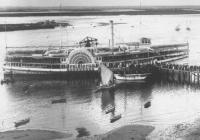 One hundred and twelve years ago today, the disaster on the General Slocum resulted in one of the largest loss of life in New York City prior to the attacks of 9/11/01.
One hundred and twelve years ago today, the disaster on the General Slocum resulted in one of the largest loss of life in New York City prior to the attacks of 9/11/01.
At around 9AM on June 15, 1904, approximately 1,350 passengers, mostly women and children from the German-American community of New York’s Lower East Side, boarded the Knickerbocker Steamship Company paddle steamer General Slocum for an annual end-of-school outing to Locust Grove Picnic Ground at Eatons Neck on Long Island. The trip was sponsored by the St. Mark’s Evangelical Lutheran Church.
Instead of a fun-filled day away from the city, the trip shortly turned into a nightmare. Continue reading

Sunset at Gowanus Bay in the Bay New York (1851) by Henry Gritten
I am looking forward to going the Working Harbor Committee’s Hidden Harbor Tour of Gowanus Bay. It will be lead by Captain Margaret Flanagan, Maritime Operations, Waterfront Alliance & Joseph Alexiou, tour guide and author of “Gowanus Brooklyn’s Curious Canal” and will include the Erie Basin, Red Hook and Sunset Park. It should be a great tour. Click here for tickets.
There are many interesting things to check out in Gowanus Bay, but what I am especially looking forward to is passing the Gowanus Canal. When I first came to the New York area to work for Moore McCormack Lines, their terminal was at 23rd St, Brooklyn on the Gowanus Canal. I recall reading somewhere in a company history that the terminal location was near where Brooklyn born Emmet J. McCormack, one of the two founders of the line, liked to swim as a child. The story is likely to be apocryphal as Gowanus Creek had been dredged into a canal and was heavily industrialized by the 1890s, when young Emmet would have chosen to take a dip.
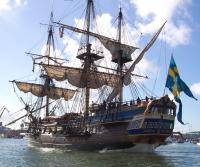 Sad news. The Götheborg, a replica of an 18th-century Swedish East Indiaman, is for sale. The Ostindiefararen Götheborg Foundation which owns the ship says it can no longer afford to run the replica, which is one of the world’s largest operational wooden sailing vessels. The Götheborg made her maiden voyage in 2005 and is modeled after the East Indiaman of the same name which sank on September 12, 1745, while approaching Götheborg harbor on her return from a third voyage to China.
Sad news. The Götheborg, a replica of an 18th-century Swedish East Indiaman, is for sale. The Ostindiefararen Götheborg Foundation which owns the ship says it can no longer afford to run the replica, which is one of the world’s largest operational wooden sailing vessels. The Götheborg made her maiden voyage in 2005 and is modeled after the East Indiaman of the same name which sank on September 12, 1745, while approaching Götheborg harbor on her return from a third voyage to China.
From the foundation press release: “This is a tough decision that we’ve been forced to make,” says Lars G Malmer, Chairman of the owning Foundation. “We’ve done our utmost to find a solution that would enable the ship to continue sailing and to serve as the amazing platform for marketing Sweden and Gothenburg that it is.”
 The upscale supermarket, Whole Foods, is taking an innovative approach to countering the spread of an invasive species of fish in Florida. They offering lionfish for sale. It is sort of a “if you can’t beat’em, eat’em” approach to managing an invasive species. A Whole Foods spokesman says that the fish’s “white, buttery meat lends itself to a number of different recipes.” The supermarket’s workers will remove the venomous spines before consumers purchase the fish, according to the statement.
The upscale supermarket, Whole Foods, is taking an innovative approach to countering the spread of an invasive species of fish in Florida. They offering lionfish for sale. It is sort of a “if you can’t beat’em, eat’em” approach to managing an invasive species. A Whole Foods spokesman says that the fish’s “white, buttery meat lends itself to a number of different recipes.” The supermarket’s workers will remove the venomous spines before consumers purchase the fish, according to the statement.
Lionfish are a stripped feathery-finned invasive species with venomous spines that have been spreading rapidly since the 1990s along the southeast coast of the U.S., the Caribbean, and in parts of the Gulf of Mexico. The fish were introduced to the region area after aquarium collectors released them in the waters of South Florida. Native to the Indo-Pacific, the lionfish lack natural predators and have been laying waste to local fish and shrimp populations.
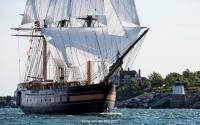
Photo: Onne van der Wal
This sounds like a great opportunity for licensed deckhands. The Sailing School Vessel (SSV) Oliver Hazard Perry is looking for crew. From their recent announcement:
Oliver Hazard Perry Rhode Island (OHPRI) is seeking to hire licensed deckhands for its brand new 200-foot SSV Oliver Hazard Perry, which is based in Newport, R.I. and scheduled to sail throughout New England this summer. The Tall Ship is the first full-rigged ocean-going ship to be built in the United States in over 100 years and requires that crew applying hold an Able Seaman license or Masters license (any tonnage) with auxiliary sail endorsement or international equivalent.
 Once again, the media is reporting a story of the discovery of a shipwreck which sounds very familiar. Recently, the Independent reported: “The wreckage of a 500-year-old Portuguese ship filled with gold coins has been unearthed by miners in a Namibian desert. The haul was discovered by diggers from diamond company De Beers and is believed to be worth upwards of £9m.” The ship was quickly identified as the Portuguese trader Bom Jesus, which vanished in 1533.
Once again, the media is reporting a story of the discovery of a shipwreck which sounds very familiar. Recently, the Independent reported: “The wreckage of a 500-year-old Portuguese ship filled with gold coins has been unearthed by miners in a Namibian desert. The haul was discovered by diggers from diamond company De Beers and is believed to be worth upwards of £9m.” The ship was quickly identified as the Portuguese trader Bom Jesus, which vanished in 1533.
Bom Jesus? That name sounds very familiar. In fact, the Bom Jesus was discovered at that location in 2008. We wrote about it in 2009 in “Gold and Ivory Shipwreck on a Beach of Diamonds.” Continue reading
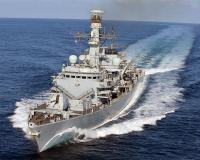 Naval ships are very expensive to build and operate and in the best of all possible worlds would never be used. Nevertheless, they exist for a purpose. Recently, while taking part in commemorations for the Battle of Jutland centenary, HMS Kent intercepted a Russian submarine as it cruised towards the English Channel. It was reported that the Stary Oskol, a Kilo-class submarine capable of carrying cruise missiles and torpedoes, was first detected by NATO forces in the North Sea. HMS Kent escorted the submarine past the Strait of Dover on Wednesday morning.
Naval ships are very expensive to build and operate and in the best of all possible worlds would never be used. Nevertheless, they exist for a purpose. Recently, while taking part in commemorations for the Battle of Jutland centenary, HMS Kent intercepted a Russian submarine as it cruised towards the English Channel. It was reported that the Stary Oskol, a Kilo-class submarine capable of carrying cruise missiles and torpedoes, was first detected by NATO forces in the North Sea. HMS Kent escorted the submarine past the Strait of Dover on Wednesday morning.

